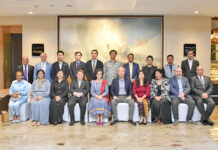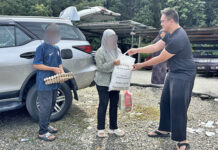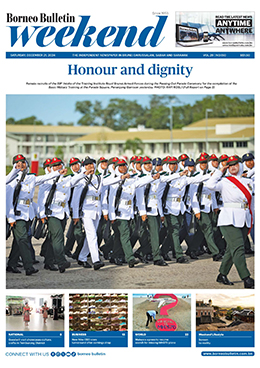At 80 years old, Lim Siew Yong is living proof that age is no barrier to learning.
Standing proudly among hundreds of graduates at the recent 12th Universiti Teknologi Brunei (UTB) convocation, Lim’s academic journey illustrates that keeping the mind sharp through new challenges is essential, whether you’re middle-aged or well into your golden years.
For Lim, pursuing a master’s degree was more than just a way to stay mentally active; it was an opportunity to contribute to the society while advocating for the idea that older learners are just as capable as their younger counterparts.
This inspired Lim to approach his supervisor with the idea of collaborating to develop an early warning system for landslides, aimed at saving lives and protecting property as part of his contribution to society.
“My two-year research project at UTB was on rainfall induced slope failure and I plan to make full use of my research for the good of the community,” shared the Master’s in Civil Engineering graduate.
This, however, is not Lim’s first notable contribution to national development; his earlier achievements have already made a significant impact in the Sultanate.
In 1966, at 22 years old, Lim set off to the United Kingdom (UK) to pursue civil engineering at Manchester University. Two years later, he graduated and secured a position with a prestigious international firm offering design, engineering, and technical expertise, based in London.


“We collaborated on the iconic Sultan Haji Omar ‘Ali Saifuddien (SHOAS) Bridge, which was designed and constructed between 2009 and 2019. We delivered the project on time, without litigation or additional claims from the contractor. It was a great success, and we are incredibly proud of it.”
Lim’s professional journey also saw him earn prestigious qualifications, including Chartered
Engineer (UK), corporate membership in the Institution of Civil Engineers (MICE), and membership in the Institution of Surveyors, Engineers and Architects (PUJA).
These accomplishments were his main focus at the time, which is why it took him longer to return to academia and pursue his master’s degree.
THE PURSUIT OF KNOWLEDGE
Though Lim was heartened to pursue further studies to enhance his civil engineering knowledge, he faced significant obstacles along the way.
Despite choosing the more challenging path of intensive coursework, his return to academia after more than five decades was fraught with difficulties, particularly given his age and the contrast with younger university students.
In his first semester, Lim encountered an unprecedented challenge by failing a core module – a first in his academic career.
This setback was a major blow, but Lim remained resolute. He passed the re-sit and completed the remaining three semesters without further issues, never once considering abandoning the opportunity provided by UTB.
UTB’s master’s programme was rigorous, with demanding exams and challenging coursework. To meet these demands, Lim dedicated substantial time to studying, utilising resources like YouTube to grasp difficult concepts.
He also undertook mini-projects, such as evaluating hotel construction feasibility and conducting advanced concrete technology research.
The projects required him to tackle unfamiliar tasks like MARR, NPV, IRR, sensitivity analyses, and risk assessments.
Lim’s commitment extended to gathering data from key staff across various agencies for his projects, a time-consuming and demanding process. Additionally, he devoted himself to a two-year research project on the ‘Effects of Rainfall Patterns on Slope Instability’.
Despite the taxing nature of these responsibilities, Lim’s perseverance and dedication enabled him to successfully navigate these challenges.
“I have to read up the literature on rainfall induced slope failures based on unsaturated material (USM) rather than convention approach of using saturated soil material (SSM).
“Again, many unfamiliar terms such as soil water characteristic curve (SWCC), hydraulic function curve (HCF) and matric suction cropped up.”
A LESSON IN HUMILITY
As a student, Lim approached his studies with a conscientious and open attitude, learning diligently from all his lecturers, who were significantly younger than him.
“I must confess that many topics taught in Semester 1 were new to me. Hence, I seemed to be the only one in the class asking questions. I never stopped asking my lecturers questions pertaining to the relevant topics in and off the classroom.
“I am grateful and thankful to all my lecturers who had been kind, patient and tolerant with my seemly never- ending questioning during my two years at the campus.”
Regarding his classmates, Lim warmly recalls how they supported one another throughout the learning process. Whenever he faced difficulties with software or computer functions, he didn’t hesitate to seek their help, and they willingly assisted each other.
For Lim, age was never a barrier to learning. He integrated effortlessly with his younger classmates from both the 2022 and 2023 batches, embracing the opportunity to learn from them.
He never claimed to be more knowledgeable due to his experience as a chartered engineer or a QP. Instead, Lim approached each interaction with humility, recognising that he had much to learn from his peers. Recalling his first day at the UTB campus in 2022, Lim fondly shared how he was met with acceptance and respect from everyone around him.
Despite being a 78-year-old among much younger students, he was neither singled out nor met with surprise or prejudice.
No one questioned his decision to pursue studies at his twilight years.
This warm acceptance continued with the second batch of students and lecturers in 2023, where his presence was met with the same genuine respect.
DISCOVERING GREENER PASTURES
Reflecting on his UTB experience, Lim acknowledged how some of the courses like Advanced Concrete Technology (ACT), has reshaped his view on the construction industry’s environmental impact.
He learnt that the industry releases about four billion tonnes of carbon dioxide annually, largely from producing ordinary portland cement (OPC), which emits a tonne of carbon dioxide per tonne produced.
The course deepened Lim’s appreciation for supplementary cementitious materials (SCM) like pulverised fly ash (PFA), which reduces cement use and energy consumption.
“PFA, an industrial by-product, can replace up to 35 per cent of cement in concrete (Dobrowolska, 2021), thus lowering the carbon footprint,” shared Lim.
Post-programme, Lim has embraced new habits, such as downloading and organising articles on slope failure daily, using Excel for easy retrieval and Harvard-style referencing for ongoing research.
Looking ahead, he plans to transfer his role at his place of employment to a promising young engineer and focus on developing a warning system project with UTB, continuing his commitment to both professional and personal growth.
“I’m truly happy that everyone treated me as one of their peers,” he continued with a chuckle.



















































